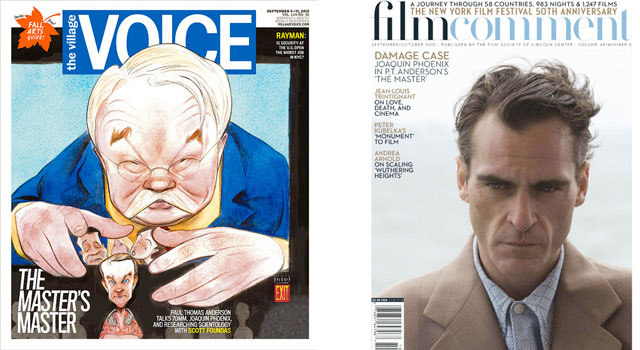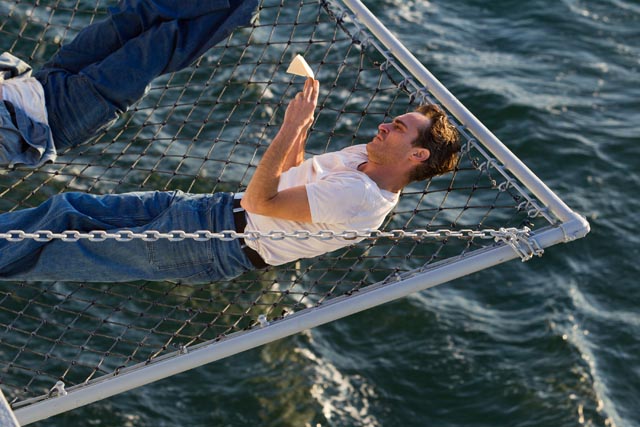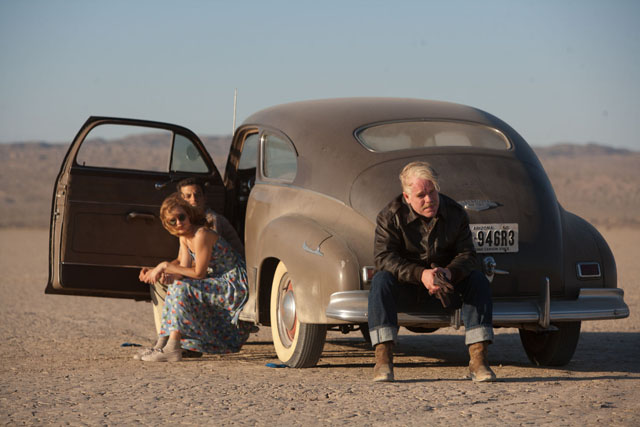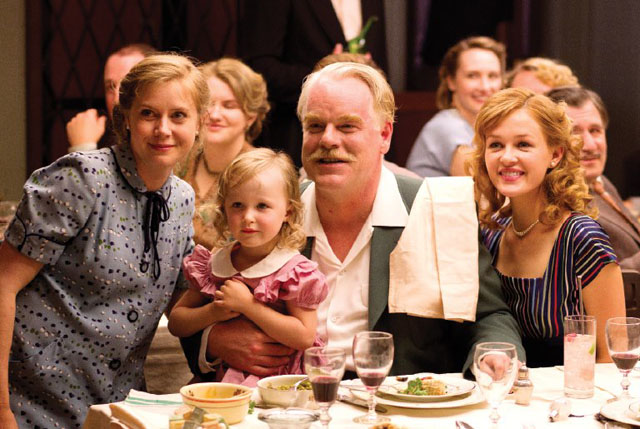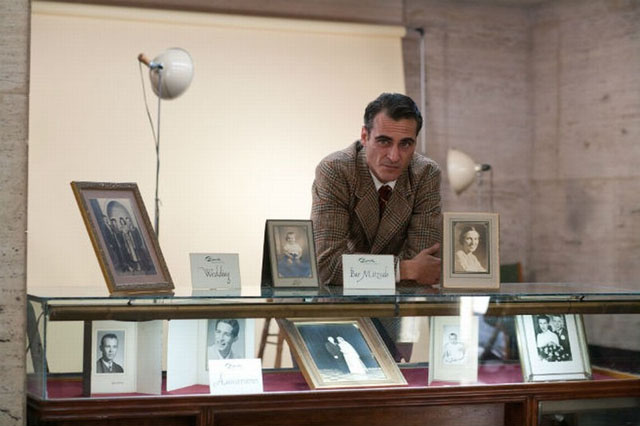With Paul Thomas Anderson’s The Master opening in New York and Los Angeles on Friday, we transition from the entry gathering first impressions quickly dispatched between screenings in Venice and Toronto to reviews written—hopefully!—under less hectic conditions. Skim towards the end of that Venice/Toronto entry and you’ll see that the transition is actually already underway with, for example, references to David Edelstein‘s review in New York, Dennis Lim‘s profile of Joaquin Phoenix for the New York Times, and Scott Foundas‘s cover story for the Voice in which, among other things, he tracks the film’s unconventional journey from pop-up benefit screenings to theaters by way of the fall season’s most prestigious festivals.
So far, the essay on The Master is Kent Jones‘s in the new issue of Film Comment. “Who is this grandiose, folksy, impetuous, self-appointed sage named Lancaster Dodd (Philip Seymour Hoffman)? Who are these wealthy people who subsidize him, invite him into their homes and onto their yachts, and listen to him with such rapt attention? And why is Dodd watching so closely over a busted wreck like Freddie Quell (Joaquin Phoenix)?” From there, Jones sketches a brief but dense outline of religious and quasi-religious movements in America, and then: “You could say that The Master picks up where There Will Be Blood leaves off. By the Forties, long after the great religious revivals and reforms, after the land has been tamed and settled, the railroads and cities built, the gold mined, the oceans of oil tapped and the fortunes of the Carnegies and Dohenys and Vanderbilts made and ensconced in legend, a mounting standardization, desperation, and rancidness has set in, and another war has left men shattered. The only conceivable frontier is within: the liberation of the self from routines, possessions, and habits of mind, whether they’ve been inculcated by trauma or affluence.”
Noir and the 70’s-era icons who influenced Anderson follow; a dash of plot and character; Phoenix’s performance; Hoffman’s performance; Anderson’s oeuvre; parting words. I haven’t seen The Master myself, but I have a hunch that Jones’s essay more than rises to the challenge it poses.
At MSN Movies, Glenn Kenny notes that The Master is “a period piece that recreates the late ’40s and early ’50s in almost microscopic detail while almost never offering a panoramic, ostensibly contextualizing perspective on those times. It’s a visually bold movie, shot with a camera that exposes a film frame nearly twice as big as 35mm and captures an attendant increase of detail, but also a movie that values the intimate close-up far more than the conventionally impressive wide shot. It’s a movie inspired in part by a real ‘master’ and the religion he founded. Yes, Lancaster Dodd bears many similarities to the Church of Scientology founder L. Ron Hubbard, and a number of incidents in the movie bear a direct relation to the creation of that ostensible church and the concoction of its urtext, Dianetics… But it’s also less about that specific set of beliefs than about how humans rely on belief systems in general to try and lift themselves out of an elemental rage, and to assert, yes, that man is not an animal. But what if man is an animal?”
The Master is a five-out-of-five-star film for Kenny and many, but not for Calum Marsh, who reviews it for Slant: “There Will Be Blood remains something of a high-water mark for a cinema of blistering miserablism, and, now that The Master has arrived and proved disappointing, it’s still P.T. Anderson’s best film. The Master‘s self-contained minor gestures are standalone pleasures strung together like beads on a string. When these moments arrive, Anderson is operating in top form; the problem is simply that, unlike the films which came before it, The Master boasts too few of them. In other words, it coasts: Where his earlier work seemed often fit to burst with the verve of tiny niceties, The Master drifts for long expanses, like the wanderer at the heart of the film, running on only the fumes of drama and action.”
And the dispatches from Toronto are still coming in. J. Hoberman, blogging for Artinfo, notes that The Master is “already so critically acclaimed that it risks suffering something of a backlash.” He suggests that it “can be read as a dramatization of Hegel’s Master-Slave dialectic in which Dodd recognizes his mastery through Freddy’s subservience and Freddy achieves consciousness through becoming Dodd’s disciple. That said, the movie hardly feels so weighty. Disorienting or slightly off-kilter, perhaps—in fact, it’s almost a comedy.”
Lee Strasberg appears (twice) in Kent Jones’s roll call of American gurus, and the LA Weekly‘s Karina Longworth, too, suggests that “the exercises Dodd leads his followers through are not unlike what might have gone on in the era’s acting classes. Processing puts Freddie inside scenes and feelings from his past—essentially the state method acting tries to get to through affective memory. If what The Master is ‘about’ can even be boiled down, then it might be about acting: To ask if a person’s nature is inherently fixed or if it can be engineered from the outside is to essentially ask if one person can teach another how to act.” Regardless: “It’s a film of breathtaking cinematic romanticism and near-complete denial of conventional catharsis. You might wish it gave you more in terms of comfort food pleasure, but that’s not Anderson’s problem. You’ve just seen too many movies about incommunicative fuck-ups who manage to break down their defenses at some convenient third-act moment, assuring that order will be restored. By not opening up that valve, The Master forces the question of whether personality change is possible—or even advisable.”
More from Linda Holmes (NPR) and Sean O’Connell (Movies.com).
“What is Paul Thomas Anderson’s best film?” Matt Singer collects a few dozen opinions at Criticwire.
At Flavorwire, you can stream Jonny Greenwood’s soundtrack.
Updates, 9/13: “The strange and complicated story it has to tell exists beyond the reach of doubt or verification,” writes A.O. Scott in the NYT. “The cumulative artifice on display is beautiful—camera movements that elicit an involuntary gasp, passages in Jonny Greenwood’s score that raise the hair on the back of your neck, feats of acting that defy comprehension—but all of it has been marshaled in the pursuit of a new kind of cinematic truth. This is a movie that defies understanding even as it compels reverent, astonished belief…. It is a movie about the lure and folly of greatness that comes as close as anything I’ve seen recently to being a great movie.”
“The haunting, utterly inward stillness of the actors in The Master is one of the director Paul Thomas Anderson’s most apparent achievements,” blogs the New Yorker‘s Richard Brody, “and it’s no mere ornament or element of dramatic plausibility—it’s at the core of the film, as is the very question of performance as such. I’ve seen the movie twice, which proved important. The first time, I found myself wondering about what it isn’t; the second, I was all the more struck by what it is. It’s not a work of psychological realism but one of extravagantly stirring symbolism masquerading as naturalism, and the first symbols that it sets in motion are the actors themselves.”
“Paul Thomas Anderson—a director who is nothing if not conscious of the relationships between his films, and also the idea of his steady ascendancy as an artist—seems to have conceived The Master in relation to its predecessor.” Adam Nayman in Reverse Shot: “In some ways, it’s a change-up: the processional quality of There Will Be Blood has been replaced by a subtler and more sophisticated structure that gives the few money shots (and this being an Anderson film, you know there will be money shots) a higher currency. But leaving aside the big question of style—and all the fascinating subplots therein, like the choice of the 70 mm format, and the hiring of relatively unheralded Romanian DP Mihai Malaimare Jr., last seen pulling 3D tricks in Twixt—the key progression is one of time and place: historically speaking, the film is a sequel.”
“Joaquin Phoenix as Freddie,” writes Nicolas Rapold for the L, “is without question the film’s heart: a hunched, sinewy figure, his torso looking like it was put on backwards, Ed Grimley-style, his lined face in frequent shot-from-below close-up, the whole simmering with rough impulses. If Phoenix, coming off a stunt sabbatical, is looking to undertake the same kind of great-works career as Blood‘s Daniel Day-Lewis, his creation of Freddie bodes well.”
And Jessica Winter‘s spoken with Phoenix for Time, where he tells her: “The key to Freddie is an animal, just pure id. For the scene where he’s arrested and put in jail and all that, I just watched videos of wild animals that get into suburbia. If you’ve seen video of a deer or a bear that finds its way into suburbia and the cops have to tranquilize it, it seems as if the brain stops working. If they’re cornered, they’ll slam into walls, or one leg tries to go left while the other is going right. It’s complete fear and chaos. They can’t control themselves at all. That was the key to Freddie.”
“Anderson has never made a more difficult film, but he hasn’t made a more mysterious one, either, or one so suffused with meaning,” writes Scott Tobias at the AV Club. “The Master’s function as an incisive shadow history of Scientology is almost incidental to the other tasks it’s trying to accomplish. Defiant in the face of rapid digital conversion, Anderson gives celluloid the victory lap it deserves. Seen in 70mm, it’s a processing session on an epic scale, an amplification of wounded souls.”
Fernando F. Croce in MUBI’s Notebook: “It’s not without flaws (which I suspect will be amplified rather than smoothed over by subsequent viewings), yet it lingers as a simultaneously scorching and icy vision from a filmmaker who continues to locate the edge of the world in unexpected pockets of America.”
“While there are no gay characters, unlike Anderson’s Boogie Nights, there’s a greater homoerotic charge between Freddie and Lancaster than I’ve ever felt between two men in an Anderson film.” Steve Erickson in Gay City News: “But for all the passion mustered by Phoenix, the final third of The Master grinds to a halt. The Cause purports to offer visions of past lives, but it can’t offer a satisfying ending.”
“The movie is surprisingly bereft of ramifications, a dramatic shortcoming that seems unusual for Anderson,” finds Time Out New York‘s Joshua Rothkopf. “Up to now, the director has built an ace catalog unified in its critique of the uniquely American (even Californian) penchant for shapeshifting. You expect a tale of Scientology to fit right in, but the script never gets around to Hubbard’s Hollywood and notorious days of black magick. It’s a missed opportunity.”
More from Marc Campbell (Dangerous Minds) and Richard Lawson (Atlantic Wire).
At Slate, Forrest Wickman posts and comments on PTA’s The Dirk Diggler Story (1988), Cigarettes & Coffee (1993), and Couch (2003) and links to a few music videos as well, one of them being Fiona Apple’s “Across the Universe.” At Grantland, Steven Hyden, looks back at the “coolest, dorkiest, sexiest, and most indelible celebrity power couple of the ’90s… Smarter than Johnny and Winona, less tragic than Kurt and Courtney, truer than Julia and Lyle—Paul and Fiona were ultimately just as doomed.”
Updates, 9/16: Nick Schager: “Anderson’s interior spaces (department store, boat cabins, a Pennsylvania house) reflect his characters’ circumstances—including Dodd’s pent-up true-believer wife Peggy (Amy Adams)—as being circumscribed by both a society that doesn’t accept them, and by their own inner fury, misery and discontent. The director visualizes this without look-at-me flair, regularly highlighting the disconnect between foreground and background spaces through varying shallow and deep focus cinematography. Paired with Jonny Greenwood’s nerve-jangling clickity-clacking score, his aesthetics have a cool, measured beauty that create an unerring mood of volatile madness, and of a need to escape, as evidenced by those few moments (a sprint across a field; a motorcycle ride through the desert) that find characters fleeing toward some indistinct and unattainable freedom.”
Nick Pinkerton, in another excellent column for Sundance NOW: “If Phoenix’s Freddie Quell doesn’t specifically bring [James Dean’s performance in George Stevens’s Giant (1956)] to mind, it is only because Phoenix seems so entirely to have summoned the spirit of Dean’s spiritual big brother, Montgomery Clift—it’s in the bristling, vexed black brows, the concave chest and jagged elbows from akimbo arms, even in Phoenix’s harelip-ish scar and half-snarl, suggesting the damaged, post-auto-accident Clift, not the beautiful young man who suffered so vividly in A Place in the Sun (1951) under the direction of none other than George Stevens.”
“Eyes caved in so much that to converse he needs to tilt his head back and squint at his interlocutor, arms dangling and crook’d behind him, a frail body bent in some twisted parody of ‘sea legs,’ Phoenix is the embodiment of a neurotic mind and discomfited spirit misshaping its bodily casing,” writes MUBI’s Daniel Kasman. “Suddenly I’m thinking of Vincent D’ONofrio in Men in Black!”
Salon‘s Andrew O’Hehir: “I’m torn between thinking he goes way over the top and thinking that he makes you feel the pain that Freddie, a battle-scarred war veteran battling a mental illness he cannot begin to understand, must endure every second of every day.”
But back to the film. “It’s a mess; it’s pretentious; it is thundery with dismay,” finds David Thomson, writing for the New Republic: “It may be acclaimed in the anxiety that grips many film critics. But the best and most interesting thing to be said about it is that a young master has gone off the deep end and found no water in the pool. So it makes you laugh out loud at its being such a disaster, and it may be a turning point in Anderson’s career, the experiment that teaches him to swim in a different way.”
“Steeling yourself for incomprehension is a good way to prepare,” advises Time Out Chicago‘s Ben Kenigsberg. “The movie is primarily a sensory experience: You could spend an entire first viewing tuning out the dialogue, just admiring the immaculate ’50s suits or the way the camera dollies around a mink-coat model sashaying through a department store…. Cinema as thought experiment, The Master is about many things: the nature of communities, the fate of mentally ill veterans (an old noir theme), even the cinema itself.”
“It’s a movie that seems to unfold at a distance, aesthetically dazzling but emotionally remote,” finds Slate‘s Dana Stevens. For the Los Angeles Times‘ Kenneth Turan, it’s “as if its creator didn’t want us to see all the way into its heart of darkness.”
“Lancaster, grown in power and yet more hollow than ever, offers up what may be the key to the film to his wayward ward,” notes Alison Willmore at Movieline: “‘If you figure out a way to live without a master, any master, be sure to let the rest of us know, for you would be the first in the history of the world.’ In Freddie, terrible and free, is an image of a life unbounded by rules and unmarked by submission to any structure, whether it be an abstract figure or the one ensconced in his self-created institute, promising a cure for what ails you.”
“In The Master, life is lived forward with choppy unevenness,” writes Ella Taylor for NPR, “but it is best understood backward, as the opening act of a falling apart whose fruits we are reaping now.”
“I was astonished at the 70mm image before me,” blogs David Bordwell. “Not a scratch, not a speck of dust, not a streak of chemicals, and no grain. So did it have that cold, gleaming purity that digital is supposed to buy us? Not to my eye. The opening shot of a boat’s wake, which will pop up elsewhere in the movie, was of a sonorous blue and creamy white that seemed utterly filmic. Now we know the way to make movies look fabulous: Shoot them on 65.”
Interviews with PTA: Michael Phillips (Chicago Tribune) and James Ponsoldt (Filmmaker). And don’t miss John H. Richardson‘s piece for Esquire, “The Secret History of Paul Thomas Anderson,” which isn’t all that secret but makes for pretty fun read.
Meantime, The Master‘s done quite well on its opening weekend; Pamela McClintock has the numbers in the Hollywood Reporter.
Update, 9/17: Here’s how Ignatiy Vishnevetsky‘s outstanding Notebook review begins: “A well-researched period piece that counterposes a cartoony anti-hero with a duplicitous religious leader—sounds an awful lot like There Will Be Blood, doesn’t it? But in spite of these and other similarities (eccentric sound design, period-perfect diction, Jonny Greenwood score), Paul Thomas Anderson’s latest ‘State of the American Dream, Circa…’ movie has more in common with his 2002 romance Punch-Drunk Love. Absorbing but also curiously inert, The Master is a very small film writ very, very large—a moody, loopy two-hour-plus character study, which (if you’re feeling extra, extra-textual) doubles as an exploration of post-war American malaise. It is emphatically not a big, loud exclamation-mark movie à la There Will Be Blood (though it actually features louder, crazier yelling), and is defined more by what it eschews—explicit character psychology, resolutions, catharsis, a third act—than what it presents. It’s an imperfect film. Some scenes drag; others are just boring. Much of The Master‘s second half feels diffuse, obtuse, abstruse—basically every -use word I can think of. And yet the first hour or so of the movie constitutes the finest filmmaking of Anderson’s career—go-for-broke virtuoso use of cinema as a medium.”
Updates, 9/19: “The movie is very Wellesian,” argues Patrick Z. McGavin: “the opening owes a great deal to Orson Welles’s great 1946 noir The Lady from Shanghai. In The Master, the fates of the two men intersect after Freddie seeks shelter on the yacht, lent by a wealthy New York benefactress, Dodd has commanded to carry out his unorthodox religious practices. In The Lady from Shanghai, the yacht party moves from New York to San Francisco. Anderson reverses that movement. Hoffman, imperial, baroque and charming, has the Wellesian bravado just right.” All in all: “I doubt seeing another movie this year that leaves me so exhilarated and unfulfilled.”
“What parts of the movie, exactly, are based on Hubbard and the secretive religion he founded?” asks Slate‘s Forrest Wickman. “[W]e’ve compared these two religions and their founders to delineate exactly where Scientology ends and The Master begins.”
Weirdly, the Playlist is claiming credit for the title of the film, setting off, naturally, enough, a storm of comments.
Via Ray Pride:
Updates, 9/23: Geoffrey O’Brien for the New York Review of Books: “That everything should come down to one man singing an old standard to another man across a desktop is a fulfillment of a confrontation that gives the film its center—a center for a film about, precisely, decenteredness and drift. The multiple story lines of earlier Anderson films give way to the dyad in which Freddie Quell and Lancaster Dodd circle around each other in a slow dance of attraction and repulsion. The simplification of structure yields an operatic power, with all superfluous details elided and the drama grounded in these two figures.”
“The problem with The Master is that it’s all deft suggestion,” finds Mike D’Angelo, writing for the Nashville Scene. “Anderson is a born filmmaker, but as a writer, he’s exasperatingly vague. His crafty modus operandi involves introducing various thematic signifiers and then declining to tackle the actual themes. All of his films suffer to some extent from this noncommittal approach, but the void is usually more expertly disguised than it is here. By the middle of the second hour, you can almost feel the resistance as various elements fail to coalesce. The final scene between Freddie and Dodd, in particular, plays like a magnificent evasion tactic—what happens is unexpected, and rich with innuendo, and perhaps even oddly moving. But it’s in no way a culmination, much less a resolution.”
“My main complaint with PT Anderson’s previous film, There Will Be Blood (2007), is that the meticulous period detail is window dressing rather than anything like a real historical context, which is why I’ve never been convinced by readings of it as an analysis of a particular development in capitalism (or religion, for that matter).” Darren Hughes: “The Master, I’d argue, is about post-WWII America in a way that Blood is not about the early-20th century oil boom.”
“So where does ‘meaning’ rest in The Master?” asks Jason Sperb. “Clearly, in the endless pontification of Lancaster Dodd (Philip Seymour Hoffman)—a cult leader who trades not so much in lies, but in nonsense—in the Deleuzian sense of the word. The character of Dodd continues Anderson’s long preoccupation with the hollow mechanisms of celebrity…. Freddie, on the other hand, better embodies the post-war condition—an angry animal without a purpose, whose only skills are making booze and taking photos. Does he embrace photography because he knows it lies? Lies, both because WWII revealed the limits of film to truly capture the horrors of war and to be an instrument of propaganda, and because post-war America embraced film’s ability to re-imagine the outside world though its surface unrealities? He dreams of Dodd calling him while falling asleep in a movie theatre—(‘A captain never abandons his ship’).” And he follows up with more thoughts.
“Phoenix’s brilliant performance as Quell is a cross between Richard Nixon’s round-backed awkwardness and a sack full of wet, hungry wolverines,” suggests the Stranger‘s Paul Constant. “Hoffman, with his mustache, resembles a particularly self-satisfied walrus, but he acts more leonine, with a predatory eye toward the people who call him Master and a desperate desire to keep his pride safe, fed, and happy so that they don’t turn on him. He doesn’t have to defend himself often, but when he does, the ferocity renders Quell a teddy bear in comparison. And Adams can poison with her words before you even realize she’s broken your skin.”
More on the performances from Ray Pride at Newcity Film: “Hoffman’s substantial frame is square-shouldered like the shoulders of the period suits: he could be Hubbard, and Elmer Gantry, and Orson Welles, the character and his Wellesian inflatables, as he invokes increasingly combative banalities to explain the universe and increase his flock. Phoenix discovers ever more remarkable ways to sort and mass his mouth and jaw, more than even Rodin found to sculpt the human shoulder at stress. There’s simian stutter to his misshapen gait, as if shrapnel pierced him at each and every insistent masturbatory thought. This is a carnival of gestural extremes.”
“Nothing as big and strange and right as The Master should feel as effortless as it does,” writes the Boston Globe‘s Wesley Morris.
“The Master is fabulously well-acted and crafted,” writes Roger Ebert, “but when I reach for it, my hand clo

